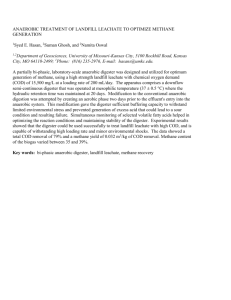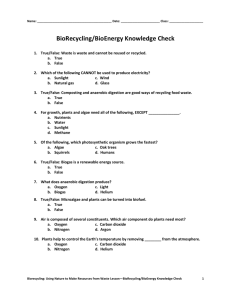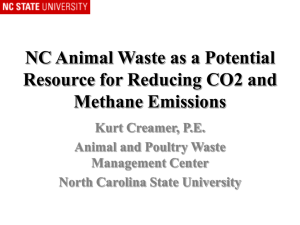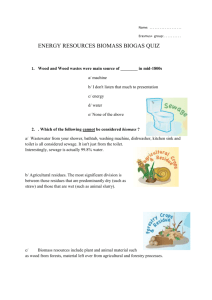Biogas & Anaerobic Digesters
advertisement
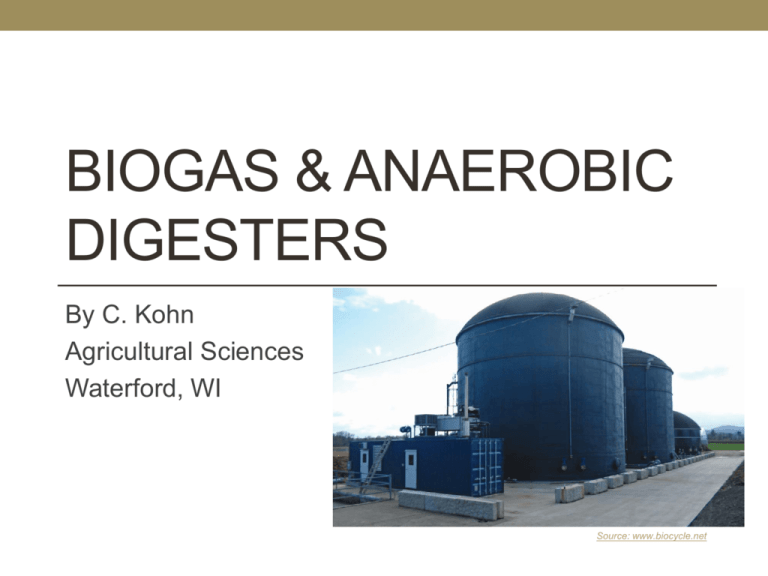
BIOGAS & ANAEROBIC DIGESTERS By C. Kohn Agricultural Sciences Waterford, WI Source: www.biocycle.net Methane • Methane is the second most prevalent greenhouse gas emitted in the US from human activity. • Methane accounts for 9% of greenhouse gases. • Methane is one of the most potent greenhouse gases with over 20 times the heat-retaining capacity as CO2. • Methane occurs from decomposition, manure, landfills, and leaky natural gas facilities. • It can also be produced naturally by wetlands, oceans, volcanoes, and other sources. • Natural gas and petroleum production account for the greatest human-caused methane emissions (30%) • Ruminant animals and their waste account for 23% of methane emissions. • Landfills generate the third-most methane at 17% of US emissions. Source: www.epa.gov Methane & Biogas • While methane is a potent greenhouse gas, it can be used to produce energy as a biogas. • When methane is burned to produce energy (such as in an electrical generator or an automobile engine), it is released as CO2 and H2O. • While CO2 is also a greenhouse gas, it is far less potent than methane. • While methane only accounts for 9% of human-caused emissions, eliminating these emissions would equate to removing 180% of carbon dioxide emissions! • The use of anaerobic digesters on farms could drastically reduce the second-leading cause of anthropogenic methane emissions. • Anthropogenic = human-activity related. • This could also provide distinct economic and energy-security benefits to the US. Source: 1goldenworld.com Biogas • Biogas is a gaseous fuel (usually methane) that is produced through fermentation of organic matter. • Biogas is produced through a process known as anaerobic digestion, which is decomposition without oxygen. • Biogas can be used to produce electricity or heat or it can be used as a transportation fuel if it is compressed. • Biogas is usually 50-80% methane; the remaining percentage is mostly carbon dioxide with a mixture of trace gases. • Biogas is different from natural gas, which is 70%+ methane with the remainder being other petroleum products (such as propane and butane). • Biogas can be made from sewage, animal byproducts, and from agricultural, industrial, and municipal solid waste. • Agricultural anaerobic digesters hold strong economic potential as a source of biogas. Source: www.biocycle.net Anaerobic Digesters • Anaerobic digesters (or methane digesters) collect manure and convert the organic molecules in the manure into methane. • This methane can then be used to produce electricity, for heating or cooling processes, or as a transportation fuel (if compressed). • Digesters are usually used to produce electricity due to the near-constant demand (as opposed to heating oil, for example, which has fluctuations in demand). • The biological mechanisms of an anaerobic digester is as follows: 1. 2. 3. 4. Organic matter (such as manure) is consumed by acid-forming bacteria. The bacteria break the organic matter into simple organic acids (such as acetic acid, proprionic acid, etc.). Methane-forming bacteria then consume the organic acids and convert them into methane/biogas. The biogas is then used to produce electricity (which can be used or sold), to power on-farm needs (such as refrigeration of milk or heating a water heater), or it can be compressed and stored to be used as transportation fuel. Source: www.skyrenewableenergy.com Statistics • A 100 cow dairy farm would need a round tank 18 ft wide and 19 feet tall to process the manure produced by these cows. • A pig farm with 200 sows would need a 24 x 25 tank. • A 1400 lb. dairy cow can produce over 46 cubic feet of biogas per day, resulting in 28,000 BTU’s of energy. • In a digester, this could produce 18,000 BTU’s of net energy (after subtracting the amount of energy needed to power the digester). • This could produce $15.45 per cow per year, or $7725 of additional gross income to a 500-cow dairy farm. • If the biogas were converted into L.P. Gas (for transportation fuel), the average dairy cow could add $41.60 of additional gross income per year to a farm (at $0.58 a gallon). • This equates to $20,800 of additional gross income for a 500 cow farm. Source: www1.extension.umn.edu Digester Benefits • Besides additional income, a anaerobic digester provides the following benefits: • On-farm source of energy independent of rising fuel costs, allowing for more • • • • • constant and predictable energy costs. Reduced odors – the aspects of manure that cause odor are what are also used to produce methane. When burned, this methane will be odorless, reducing odors from the farm. High Quality Fertilizer – during anaerobic digestion, organic nitrogen is converted into a more-valuable fertilizer, ammonium. Reduced Surface and Groundwater Contamination – because it produces a more valuable, more easily-absorbed fertilizer, it reduces the likelihood of water pollution (more nutrients are absorbed by the crop). Pathogen Reduction – dangerous bacteria is killed off in the manure during the digester process. Source of bedding – anaerobic digesters produce a solid byproduct that can be used for bedding for cattle. Source: www.nbcnews.com Digester Drawbacks • Anaerobic digesters can also have drawbacks – • Anaerobic digesters require additional skills and access to skilled experts and consultants. • The manure from a farm must be compatible with the digester system (appropriate moisture content, etc.). • Typically farms must have 500 cows or more to have enough waste to feasibly accommodate a digester. • Methane can become explosive if it mixes with air. • Methane leaks are difficult to detect because it is odorless, colorless, and lighter than air. • Logistical considerations – anaerobic digesters require additional work to secure the needs and concerns related to insurance, electrical exchanges, etc. such as licenses, electrical connecting costs, consulting fees, etc. Source: pinkhamwayincinerator.blogspot. How a Digester Works • Digesters are covered waste storage areas that are air- tight. • They are typically constructed from concrete or steel. • Most digesters require 20-30 days for the bacteria to convert the organic wastes into acids and then methane gas. • Most digesters utilize cogeneration, in which the heat produced by an electric generator is used to heat the digester itself to speed up the reaction time. • The bacteria in a digester are very sensitive, requiring a pH of 7 and a consistent temperature near 35o C. • Every 11 degree change from 35o causes the gas production to be cut in half. Source: www.epa.gov Digester Requirements • Farm anaerobic digesters require the following: 1. Manure Collection: waste must be delivered to the digester itself. 2. Anaerobic Digestion: in an air-tight lagoon or tank, bacteria convert the organic waste into acids and then methane. 3. Biogas Handling: the gas that results from anaerobic digestion is collected from the digester. 4. Gas-use Device: a device utilizes the gas in order to convert it into a source of power or energy (water heater, refrigeration, electrical generation, or compressed gas for transportation fuel). 5. Digester Byproduct Removal: the following byproducts must be handled after digestion is completed: • Liquid effluent (sewage) can be used as a high-quality fertilizer • Digested solids: can be used as bedding for cattle or for biodegradable planting pots; it may also hold potential as a building material Source: climatetechwiki.org Potential Impact • The US Environmental Protection Agency (EPA) estimates that there are 8200 dairy and swine operations in the United States that could support a methane digester. • Altogether, these farms could generate more than 13 million megawatt-hours of energy. • They could and displace about 1,670 megawatts of fossil fuel-fired generation collectively per year. • A typical coal-fired power plant produces 600-700 megawatts per year, so US agricultural biogas production could eliminate 2-3 coal-fired power plants. • Use of landfill biogas could eliminate even more coal-fired power plants! • Biogas production would reduce dependence on foreign oil and heavily-polluting coal power plants. • Use of anaerobic digestion would provide more income to farmers while reducing air, soil, and water pollution. Source: www.epa.gov Sources • http://epa.gov/climatechange/ghgemissions/gases/ch4.html • http://www.afdc.energy.gov/fuels/emerging_biogas.html • http://www.mda.state.mn.us/protecting/conservation/practices/diges ter.aspx • http://www.ext.colostate.edu/energytalk/ad-works.html • www.epa.gov/agstar/documents/chapter1.pdf • http://www.bae.ncsu.edu/programs/extension/publicat/wqwm/ebae0 71_80.html
